Simple Futsu Kebari
This page didn't start out being about simple futsu kebari. It started out being about north country spiders, and fishing them as they were meant to be fished, with a long rod and a horsehair line tied to the rod tip. I find the spiders to be beautiful, almost mesmerizing in their elegant simplicity. As much as I like them, though, for some time I've had a nagging feeling that they just aren't the most appropriate flies for tenkara fishing. Yes, they were first fished with a long rod that had a horsehair line tied to the rod tip. Sounds like tenkara but there is a clear difference.
The wet flies that evolved to become the north country spiders, and the spiders themselves, were fished almost exclusively downstream. (Truth be told, they still are!) It was not until WC Stewart published his book The Practical Angler in 1857 that fishing upstream was done by more than a very few. In fishing downstream, the angler did not attempt to keep his line tight by lifting the rod tip, as one does when fishing upstream. Instead, the current pushing on the line and fly kept it tight for him. Takes were generally felt, and some fish even hooked themselves as they turned after taking the fly.
Most tenkara anglers fish upstream - many almost exclusively. I was actually quite surprised, when watching Tenkara no Oni for the first few times, at how much time he spent fishing downstream. He actually fishes in every direction, positioning himself in relation to the rocks and the currents so he can get the drifts he wants. Most tenkara anglers, though (at least in the US), fish upstream or up and across.
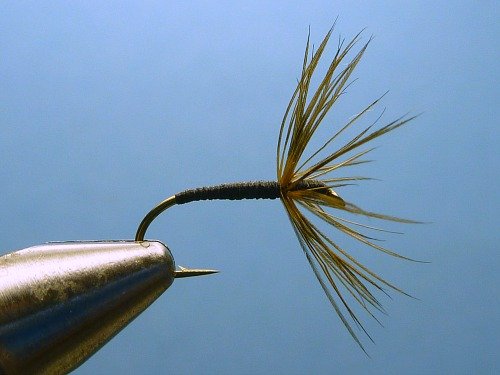 Sakasa Kebari
Sakasa Kebari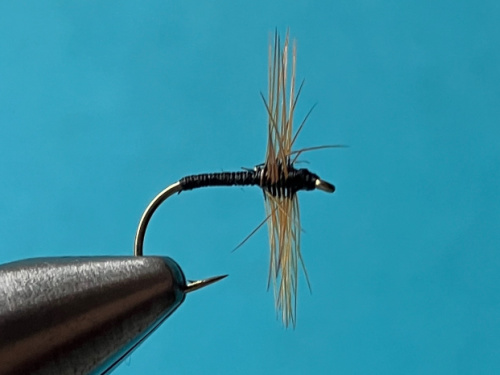 Futsu Kebari
Futsu KebariI have thought for several years that the reason why the sakasa kebari are tied with a rather full hackle and with the hackle slanting forward is that the hackle, tied in that way, resists being pulled through the water. That allows the tenkara angler to keep his line tighter and off the water's surface. More recently, I realized the hackle of a futusu kebari, being stiffer rooster hackle tied at a right angle to the hook shaft, has the same effect of resisting being pulled through the water.
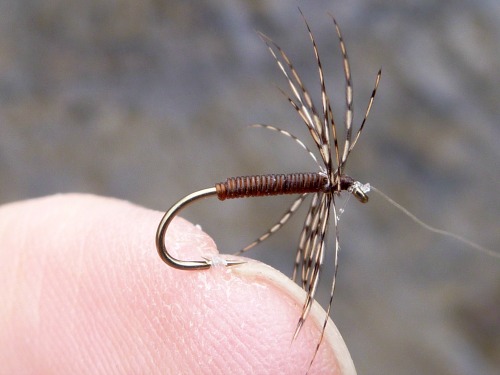 Partridge and Horsehair
Partridge and Horsehair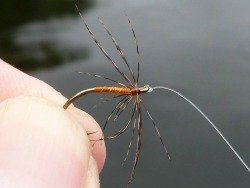 Partridge and Orange
Partridge and OrangeThe very sparse, very soft game bird hackle tied on a north country spider, on the other hand, will fold back against the hook shank as the fly is pulled through the water. The combination of the line wanting to hang straight down from the rod tip and the angler raising the rod tip in an attempt to keep the line tight and above the surface will pull the fly from the moment it touches the water. A very sparse soft hackle will provide virtually no resistance, and thus will not help to keep your line tight and off the surface.
In thinking about how to blend the look of a north country spider with the resistance of a sakasa kebari or futsu kebari, I remembered once reading that anglers occasionally added a stiff rooster hackle immediately behind a soft game bird hackle to support it. In trying to again find where I'd read that, I came across a Scottish pattern called a Jingler.
The Jingler is a dry fly, but a dry fly can be fished wet if it is not treated with floatant. If the hackle is just a bit sparse, if the fly is tied without a tail, and if it is tied on a heavier, wet fly hook, after the first few drifts it will sink.
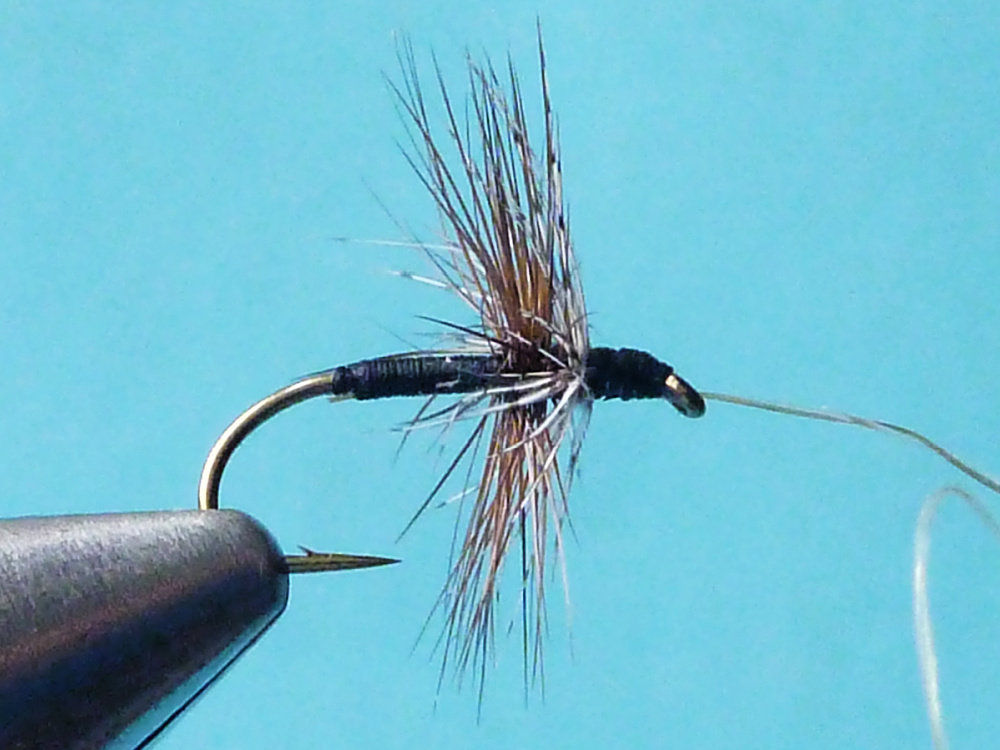 Ishigaki-inspired Jingler(?)
Ishigaki-inspired Jingler(?)snelled to horsehair
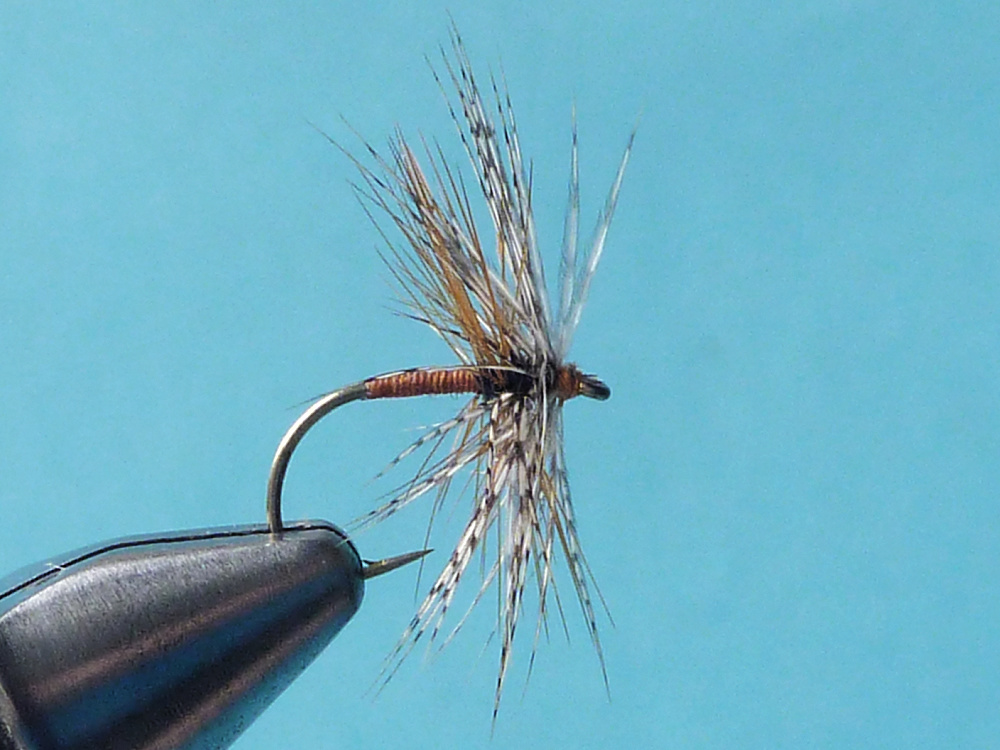 Jingler(?) and waxed orange
Jingler(?) and waxed orangeI'm not at all sure that either of the above flies would be considered Jinglers (even if they had tails), but I'd have to say I'm not taken with their looks. Perhaps if the partridge was a bit fuller and the rooster hackle a bit sparser I would be happier with it. For that matter, a couple turns of brown hackle and a couple turns of grizzly would give almost the same impression. They're scruffy, and scruffy flies do catch fish, but the look clearly is not the elegant simplicity I was hoping for.
Perhaps it would be better to revisit WC Stewart and his Practical Angler. After all, he's the guy who advocated fishing upstream, so what did he fish? Why, Stewart Spiders, of course.
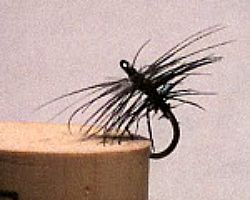 Stewart Black Spider
Stewart Black Spider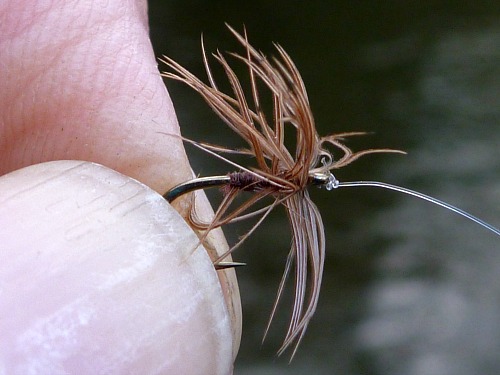 Stewart Spider tied with Quail
Stewart Spider tied with QuailThe Practical Angler described three Spiders. The Black Spider is the one everyone knows, tied with well waxed brown silk thread and a starling feather. The Dun Spider and the Red Spider were hackled with feathers that are no longer available. Yellow silk was specified for the Dun Spider, while the silk color for the Red Spider was not mentioned. No wonder the Red Spider don't get no respect. You
don't know what silk
to use and you can't get the feather anyway.
Color aside, I am at a loss to describe how WC Stewart could have kept his horsehair and silk casting line tight while fishing three small spiders. Starling feathers are extremely soft and would have provided next to no resistance to being pulled through the water. I doubt the original feathers used for the other two colors would have been significantly stiffer.
That said, I have caught fish while using a single Stewart Black Spider. A single spider surely provides less resistance than three!
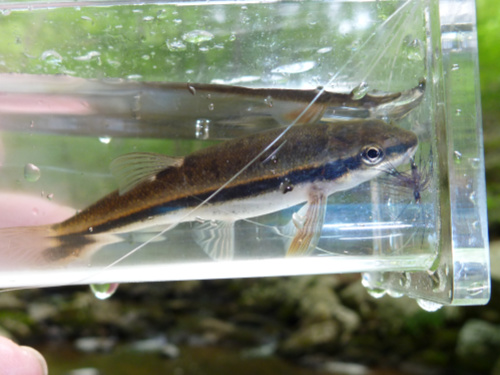 Black Nose Dace
Black Nose Dace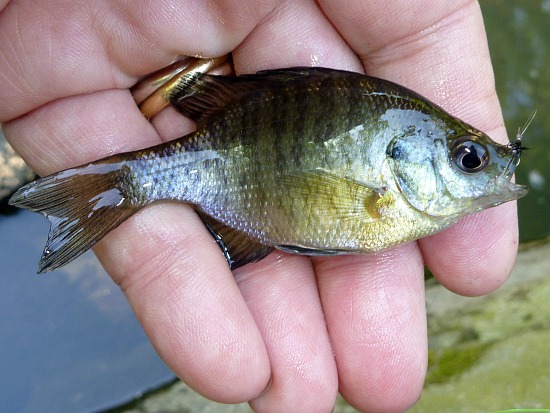 Bluegill
Bluegill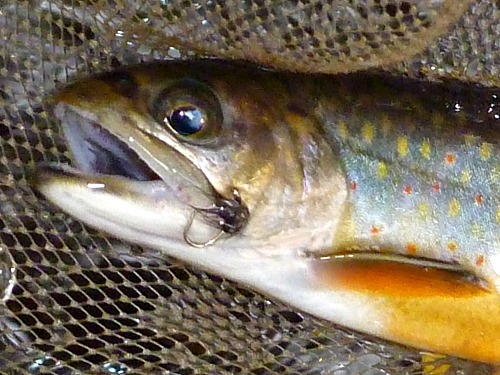 Brook Trout
Brook TroutThe more I think about this the more I think I am overthinking it. Obviously, WC Stewart was successful while fishing a team of three spiders, upstream, with a line made from horsehair and silk. Traditional Japanese tenkara anglers were successful fishing one fly, whether sakasa kebari or futsu kebari, using a long rod and a horsehair line. I've have caught fish while fishing extremely sparse flies upstream.
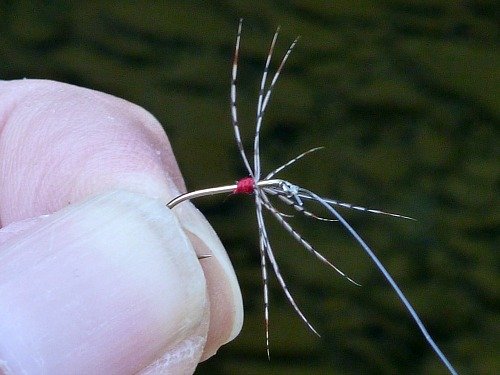 Sparse
Sparse"Red Spot"
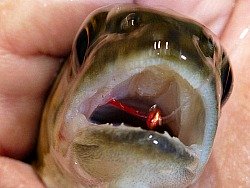 Sparser
Sparser"Daiichi Bloodworm"
(bare red hook)
Dr. Ishigaki has said at least once "The moment you realize the fly
pattern is not important, your fishing will improve." I suppose I should
just accept that he knows more than I do and that I should not obsess
over the flies. When I once asked him how he chose between his black and
gray flies, he said the color didn't matter, he just picked one.
Suprisingly, in the sixteen years I have been tenkara fishing, I think I have fished a futsu kebari only twice, and of those two, the only one that registered was the time I fished with Adam K in Colorado. He instructed me in fishing a much longer line than I had previously used, upstream, keeping the line off the water and easily detecting strikes. I think for the coming year I'm going to tie up some futsu kebari. I've got a bunch more of the cheap Walgreen's sewing thread I used for the Ishigaki Kebari page, so I may end up with some relatively sparse north country inspired, Ishigaki inspired simple futsu kebari. They might be colorful. They probably won't be pretty. The fish certainly won't care.
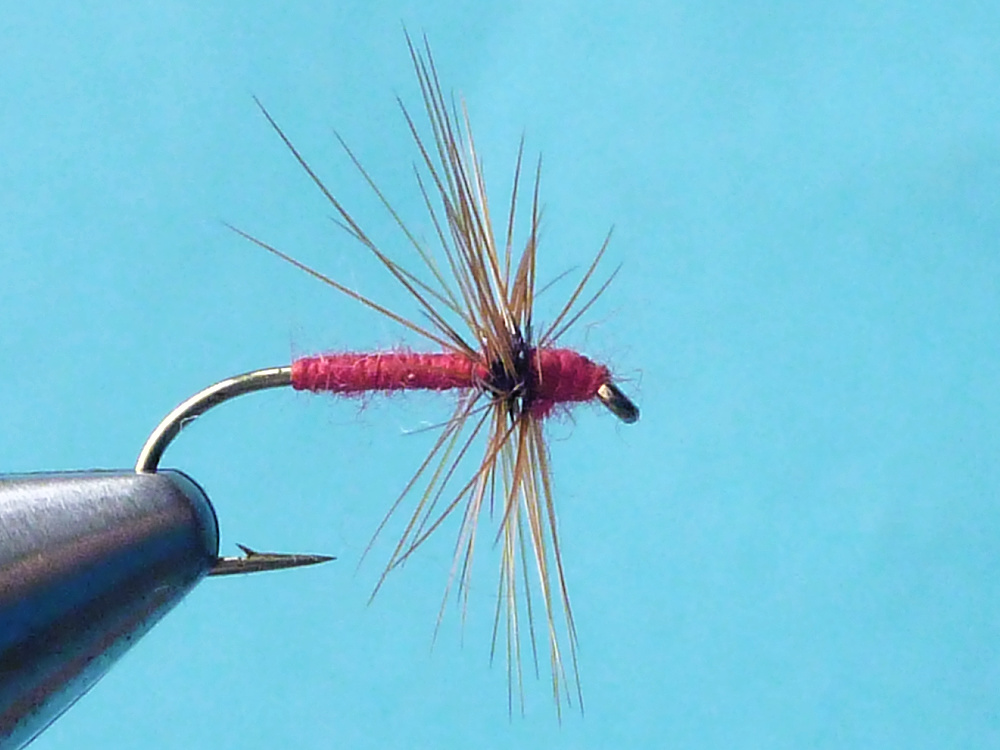
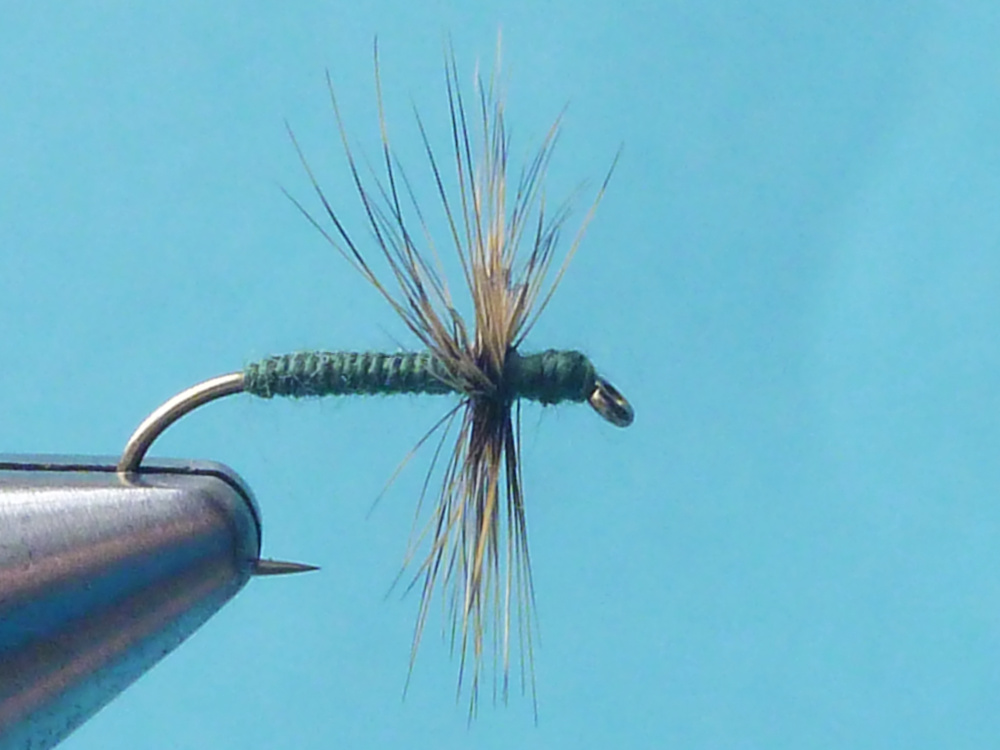
TenkaraBum Home > Hair-Brained > Simple Futsu Kebari
“The bitterness of poor quality remains long after the sweetness of low price is forgotten” - Benjamin Franklin
"Be sure in casting, that your fly fall first into the water, for if the line fall first, it scares or frightens the fish..." -
Col. Robert Venables 1662
As age slows my pace, I will become more like the heron.
We've all had situations where seriously chewed up flies kept catching fish after fish after fish. It is no sin to tie flies that come off the vise looking seriously chewed up.
Warning:
The hooks are sharp.
The coffee's hot.
The fish are slippery when wet.
Beware of the Dogma
Seriously, all the hooks sold on TenkaraBum.com, whether packaged as loose hooks or incorporated into flies, are sharp - or as Daiichi says on their hook packages, Dangerously Sharp. Some have barbs, which make removal from skin, eyes or clothing difficult. Wear eye protection. Wear a broad-brimmed hat. If you fish with or around children, bend down all hook barbs and make sure the children wear eye protection and broad-brimmed hats. Be aware of your back cast so no one gets hooked.
Also, all the rods sold on TenkaraBum.com will conduct electricity. Do not, under any circumstances, fish during a thunder storm. Consider any fishing rod to be a lightning rod! Fishing rods can and do get hit by lightning!
What's in stock?
Kurenai II AR 30F
Kurenai II AR 33F
Kurenai II AR 39F
TenkaraBum 33
TenkaraBum 36
Furaibo TF39
Furaibo TF39TA
Nissin Oni Tenkara Line
If you enjoy spin fishing or baitcasting please visit my sister site Finesse-Fishing.com.


